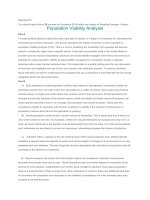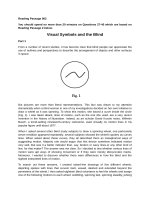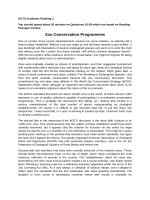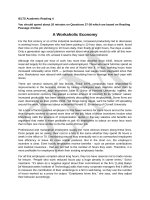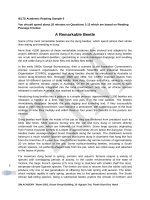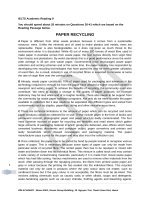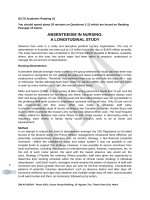IELTS academic reading 2
Bạn đang xem bản rút gọn của tài liệu. Xem và tải ngay bản đầy đủ của tài liệu tại đây (54.18 KB, 5 trang )
Reading Passage 002
You should spend no more than 20 minutes on Questions 27-40 which are based on
Reading Passage 2 below.
Visual Symbols and the Blind
Part 1
From a number of recent studies, it has become clear that blind people can appreciate the
use of outlines and perspectives to describe the arrangement of objects and other surfaces
in space.
But pictures are more than literal representations. This fact was drawn to my attention
dramatically when a blind woman in one of my investigations decided on her own initiative to
draw a wheel as it was spinning. To show this motion, she traced a curve inside the circle
(Fig. 1). I was taken aback, lines of motion, such as the one she used, are a very recent
invention in the history of illustration. Indeed, as art scholar David Kunzle notes, Wilhelm
Busch, a trend-setting nineteenth-century cartoonist, used virtually no motion lines in his
popular figure until about 1877.
When I asked several other blind study subjects to draw a spinning wheel, one particularly
clever rendition appeared repeatedly: several subjects showed the wheel's spokes as curves
lines. When asked about these curves, they all described them as metaphorical ways of
suggesting motion. Majority rule would argue that this device somehow indicated motion
very well. But was it a better indicator than, say, broken or wavy lines-or any other kind of
line, for that matter? The answer was not clear. So I decided to test whether various lines of
motion were apt ways of showing movement or if they were merely idiosyncratic marks.
Moreover, I wanted to discover whether there were differences in how the blind and the
sighted interpreted lines of motion.
To search out these answers, I created raised-line drawings of five different wheels,
depicting spokes with lines that curved, bent, waved, dashed and extended beyond the
perimeters of the wheel. I then asked eighteen blind volunteers to feel the wheels and assign
one of the following motions to each wheel: wobbling, spinning fast, spinning steadily, jerking
or braking. My control group consisted of eighteen sighted undergraduates from the
University of Toronto.
Words associated
Agreement among
with circle/square
subjects(%)
SOFT-HARD
100
MOTHER-FATHER
94
HAPPY-SAD
94
GOOD-EVIL
89
LOVE-HATE
89
ALIVE-DEAD
87
BRIGHT-DARK
87
LIGHT-HEAVY
85
WARM-COLD
81
SUMMER-WINTER
81
WEAK-STRONG
79
FAST-SLOW
79
CAT-DOG
74
SPRING-FALL
74
QUIET-LOUD
62
WALKING-STANDING
62
ODD-EVEN
57
FAR-NEAR
53
PLANT-ANIMAL
53
DEEP-SHALLOW
51
All but one of the blind subjects assigned distinctive motions to each wheel. Most guessed
that the curved spokes indicated that the wheel was spinning steadily; the wavy spokes, they
thought; suggested that the wheel was wobbling; and the bent spokes were taken as a sign
that the wheel was jerking. Subjects assumed that spokes extending beyond the wheel's
perimeter signified that the wheel had its brakes on and that dashed spokes indicated the
wheel was spinning quickly.
In addition, the favored description for the sighted was favored description for the blind in
every instance. What is more, the consensus among the sighted was barely higher than that
among the blind. Because motion devices are unfamiliar to the blind, the task I gave them
involved some problem solving. Evidently, however, the blind not only figured out meaning
for each of motion, but as a group they generally came up with the same meaning at least as
frequently as did sighted subjects.
Part 2
We have found that the blind understand other kinds of visual metaphors as well. One blind
woman drew a picture of a child inside a heart-choosing that symbol, she said, to show that
love surrounded the child. With Chang Hong Liu, a doctoral student from china, I have
begun exploring how well blind people understand the symbolism behind shapes such as
hearts that do not directly represent their meaning.
We gave a list of twenty pairs of words to sighted subjects and asked them to pick from each
pair the term that best related to a circle and the term that best related to assure. For
example, we asked: what goes with soft? A circle or a square? Which shapes goes with
hard?
All our subjects deemed the circle soft and the square hard. A full 94% ascribed happy to the
circle, instead of sad. But other pairs revealed less agreement: 79% matched fast to slow
and weak to strong, respectively. And only 51% linked deep to circle and shallow to square.
(see Fig. 2) When we tested four totally blind volunteers using the same list, we found that
their choices closely resembled those made by he sighted subjects. One man, who had
been blind since birth, scored extemely well. He made only one match differing from the
consensus, assigning 'far' to square and 'near' to circle. In fact, only a small majority of
sighted subjects-53%- had paired far and near to the opposite partners. Thus we concluded
that the blind interpret abstract shapes as sighted people do.
Questions :
Choose the correct letter, A, B,C or D.
Write your answers in boxes 27 –29 on your answer sheet.
27 In the first paragraph the writer makes the point that blind people
A.
may be interested in studying art.
B.
can draw outlines of different objects and surfaces.
C.
can recognize conventions such as perspective.
D.
can draw accurately.
28 The writer was surprised because the blind woman
A.
drew a circle on her own initiative.
B.
did not understand what a wheel looked like.
C.
included a symbol representing movement.
D.
was the first person to use lines of motion.
29 From the experiment described in Part 1,the writer found that the blind subjects
A.
had good understanding of symbols representing movement.
B.
could control the movement of wheels very accurately.
C.
worked together well as a group in solving problems.
D.
got better results than the sighted undergraduates.
Questions 30 –32
Look at the following diagrams (Questions 30 –32), and the list of types of movement below.
Match each diagram to the type of movement A–E generally assigned to it in the experiment.
Choose the correct letter A–E and write them in boxes30–32 on your answer sheet.
A
steady spinning
B
jerky movement
C
rapid spinning
D
wobbling movement
E
use of brakes
Questions 33 –39
Complete the summary below using words from the box. Write your answers in boxes 33 –
39 on your answer sheet. NB You may use any word more than once.
In the experiment described in Part 2, a set of word 33.......…… was used to investigate
whether blind and sighted people perceived the symbolism in abstract 34.....…...… in the
same way. Subjects were asked which word fitted best with a circle and which with a square.
From the 35...…...… volunteers, everyone thought a circle fitted ‘soft ’while a square fitted
‘hard’. However, only 51% of the 36.......…… volunteers assigned a circle to 37.....
…… .When the test was later repeated with 38...…...… volunteers, it was found that they
made 39...…...… choices..
associations
Sighted
blind
similar
deep
hard
shallow soft
hundred
identical
pairs
shapes
words
Question 40
Choose the correct letter, A , B , C or D. Write your answer in box 40 on your answer sheet.
Which of the following statements best summarizes the writer ’s general conclusion?
A The blind represent some aspects of reality differently from sighted people.
B The blind comprehend visual metaphors in similar ways to sighted people.
C The blind may create unusual and effective symbols to represent reality.
D The blind may be successful artists if given the right training.
Answer:
27. C 28. C 29. A 30. use of breaks 31. rapid spinning 32. steady spinning 33.
pairs 34. shapes 35. sighted 36. sighted 37. deep 38. blind 39. similar 40. B
